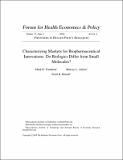| dc.contributor.author | Trusheim, Mark | |
| dc.contributor.author | Aitken, Murray L. | |
| dc.contributor.author | Berndt, Ernst R. | |
| dc.date.accessioned | 2011-04-08T20:14:32Z | |
| dc.date.available | 2011-04-08T20:14:32Z | |
| dc.date.issued | 2010-01 | |
| dc.identifier.issn | 1096-231X | |
| dc.identifier.issn | 1558-9544 | |
| dc.identifier.uri | http://hdl.handle.net/1721.1/62181 | |
| dc.description.abstract | While much has been written about the distinctions between biologics and small molecules
in terms of their scientific, manufacturing and regulatory experiences, relatively little has been
published comparing their clinical and commercial experiences. Employing a data base encompassing
all 96 biologics and 212 small molecules newly launched in the U.S. between 1998Q1
and 2008Q4, we compare their downstream clinical and commercial characteristics. Substantial
heterogeneity occurs across therapeutic classes. Biologics are more concentrated than small
molecules in their therapeutic class composition, but have obtained FDA indication approvals in
13 of 15 classes. While average delays between FDA approval and first observed sales revenues
are similar, biologics are twice as likely as small molecules to be Orphan Drugs, are slightly more
likely to be designated FDA priority rather than standard review status, and gain slightly more
supplemental indication approvals. Although 9.4% of new small molecules permanently exited
the market for a variety of reasons, 7.3% of new biologics exited, but 26% of biologics had black
box warnings compared to 20% of small molecules. Both biologics and small molecules take
21-22 quarters from launch to reach $100 million in real revenues. Small molecules have an initially
more rapid uptake, but thereafter biologics’ mean revenues tend to be slightly greater than
for small molecules. While launch prices for biologics are commonly perceived as being greater
than for small molecules, price growth per standard unit is generally greater for small molecules
than biologics, with rates of price growth increasing for small molecules in the first five years
since launch, and decreasing thereafter. We conclude that the market dynamics of biologics differ
substantially from those of small molecules, although therapeutic class composition plays a major
role. | en_US |
| dc.description.sponsorship | Pfizer Inc. | en_US |
| dc.language.iso | en_US | |
| dc.publisher | National Bureau of Economic Research | en_US |
| dc.rights | Article is made available in accordance with the publisher's policy and may be subject to US copyright law. Please refer to the publisher's site for terms of use. | en_US |
| dc.source | BEPress | en_US |
| dc.title | Characterizing Markets for Biopharmaceutical Innovations: Do Biologics Differ from Small Molecules? | en_US |
| dc.type | Article | en_US |
| dc.identifier.citation | Trusheim, Mark R., Murray L. Aitken and Ernst R. Berndt. "Characterizing Markets for Biopharmaceutical Innovations: Do Biologics Differ from Molecules?." Forum for Health Economics & Policy (Frontiers in Health Policy Research) (2010) 13.1 p. 1-45 ©2010 The Berkeley Electronic Press. | en_US |
| dc.contributor.department | Sloan School of Management | en_US |
| dc.contributor.approver | Berndt, Ernst R. | |
| dc.contributor.mitauthor | Berndt, Ernst R. | |
| dc.contributor.mitauthor | Trusheim, Mark | |
| dc.relation.journal | Frontiers in Health Policy Research | en_US |
| dc.eprint.version | Final published version | en_US |
| dc.type.uri | http://purl.org/eprint/type/JournalArticle | en_US |
| eprint.status | http://purl.org/eprint/status/PeerReviewed | en_US |
| dspace.orderedauthors | Trusheim, Mark R.; Aitken, Murray L.; Berndt, Ernst R. | |
| dc.identifier.orcid | https://orcid.org/0000-0002-6388-0768 | |
| mit.license | PUBLISHER_POLICY | en_US |
| mit.metadata.status | Complete | |
